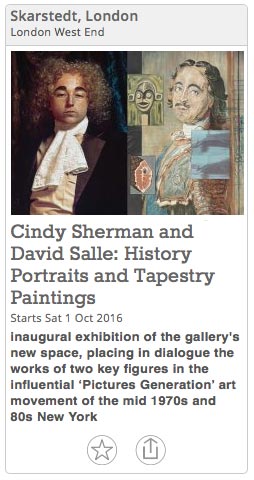

My painting is as close to improvisational theater as it’s possible to be and still look like painting.
One theme that has re-surfaced in various ways through my work over the last 40 years: the as if. By this I mean the assumption, or will toward meaning – or connection - which, on the face of it, is un-likely, improbable, or even absurd. It’s one of the first principles of improvisation, of comedy generally: begin with an absurd situation and play it for real - find its internal logic. A good comic actor does not play for laughs; he plays the comic role with a straight face. Farce is representation carried to an extreme point.

Here’s another way of putting it: I want to drive a wedge between the name and the named, between the thing and its representation. I want to interrupt the mind’s tendency to reach for automatic assumptions. But this breaking apart is only the beginning. Things are broken apart and isolated from their contexts so they can be put back together - in a new way. The re-assembling, the interweaving of images, styles, color palettes, of differing scales – of visual languages generally - that is the art part, and is carried out in a spirit of nonchalance. This is the work’s style; in my work, the style is ebullient.
This process is called composition. In musical composition, both harmony and dissonance have their uses. Often what we experience as dissonance is simply cultural familiarity. What some viewers may experience as visual dissonance is the slight awkwardness that comes from seeing exposed what is usually covered up, from excavating the deeper syntactical linkages between things, images, objects, appearances, and gestures. It’s like tearing up the street to get at the mechanics underneath. The purpose of all this destruction is to create a new sense of beauty – one that results from feeling the rightness of certain connections.
My painting is often presentational in tone. It says, “Look at this!” My paintings work within the presentational impulse, they wear its visual syntax, almost like a costume. Some pictures have an energy that is almost antic, like slapstick comedy. Other pictures have an energy that is more restrained, almost classical, but in a new way.
My work insists on visuality itself as content. The manner of making something visible is part of the painting’s style. This visuality, in its lushness and fullness, leans toward lyricism and romanticism, as well as, occasionally, the opposite: tartness, or sharpness. Some of the paintings have a “what the hell” kind of fatalism. All of my paintings value wit.

I am a compositional painter. To continue the musical analogy, think of orchestration – the art of choosing the right instrument to play the melodic line. Woodwind or brass?
In painting, the compositional structure creates a path for the eye – a journey is both implied and literalized. The viewer takes a little ride - the eye has to move.
The work is constructed, and the method of its construction produces a grammar of juxtaposition. The building blocks are visual comparisons, or counterpoints: comparisons of scale, color, image, placement, texture, direction, velocity, density, openness vs. closed, etc. A painting is a series of overlapping, contiguous, and sequential relationships. As with any relational art, what matters are the transitions – the spaces between images. Think of how a film editor structures our involvement with a story: the way one shot cuts to another, the tiny, imperceptible leap between them creates the meaning of a scene. Grammar becomes style becomes meaning.
My paintings are composed along “chord-like” clusters of painting events, some of these chords use images, others are purely painterly. Many of these pictorial/spatial/imagistic relationships are deliberately left “open”; a viewer may complete the process of bringing them into alignment. These little leaps across pictorial gaps; it’s like skipping over a crevasse while hiking in the mountains. It’s exhilarating when you realize you can do it.
 Cindy Sherman and David Salle: History Portraits and Tapestry Paintings is the inaugural exhibition at Skarstedt's new London gallery space and runs from Saturday 1 October to Saturday 26 November 2016.
Cindy Sherman and David Salle: History Portraits and Tapestry Paintings is the inaugural exhibition at Skarstedt's new London gallery space and runs from Saturday 1 October to Saturday 26 November 2016.


